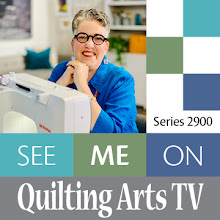Just as a chef needs to have many techniques (roasting, sautéing, frying, baking, etc.) in his or her repertoire to keep things interesting when creating a new dish, art quilters (or those just tentatively stepping into this strange new world) benefit from learning new techniques and testing out new materials. It can keep your work fresh, it can keep your brain challenged, and it can make you more creative. All of which are good things, even if the materials and techniques never make it into your work. (But I bet after you try some of them, they will!) Perhaps the best reason for trying something new is that it is fun!
In the “Creative Surface Design” class I taught at Quilters Loft Company today, we tried out a lot of these techniques, and had a ball doing it. My students asked me to post a list of the books I brought to class. So here they are.
There are many wonderful books out there that can help you learn more about these techniques, and inspire you to try them out. Here are some of my favorites right now:
 Between the Sheets with Angelina: A Workbook for Fusible Fibres
Between the Sheets with Angelina: A Workbook for Fusible Fibres, by Alysn Midgelow-Marsden in conjunction with Viv Arthur of Art Van Go (2003). Step-by-step instructions and photos show you how to fuse, melt, paint, emboss, and make vessels and wearables from Angelina fibers.
 Creative Embellishments for Paper, Jewelry, Fabric and More
Creative Embellishments for Paper, Jewelry, Fabric and More by Sherrill Kahn (2007). Gosh, there is a lot in this book! Fabric and paper beads, air-dry clay, stuffed shapes, Angelina, metal, laminated accents, Tyvek, shrink plastic, sheet protector embellishments, fun-foam, wrapped chenille pipe cleaners, stenciling, and weaving paper and fabric. Tons of projects, beautiful photos.
 Creative Quilts: Inspiration, Texture & Stitch
Creative Quilts: Inspiration, Texture & Stitch by Sandra Meech (2006). You just can’t go wrong buying a book by Sandra Meech (and she has several others). Her work is so exquisite and so varied that this is almost a “coffee table” book. It is that visually interesting. But it is also a wonderful self-study guide with specific design class sections to help you boost your creativity while you learn more about design and composition, finding a theme, texture and dimension, and exploring stitch. Plus a very good section on sketch and stitch books, and why making them can make you a better artist.
 The Painted Quilt: Paint and Print Techniques for Color on Quilts
The Painted Quilt: Paint and Print Techniques for Color on Quilts by Linda & Laura Kemshall (2007). This book was recently released. It is a wonderful combination of beautiful pieces that will inspire, and practical techniques for innovative ways to add color to quilts. Methods and techniques: painting, bleaching and discharging, pastels, dyes, image transfer, fusible web. I love this book!
 Paintstiks on Fabric: Simple Techniques, Fantastic Results
Paintstiks on Fabric: Simple Techniques, Fantastic Results by Shelly Stokes (2005). Everything you need to know about Shiva Paintstiks: rubbings, masks, stencils, etc.
And here are a few photos from the class today. They sure look serious about what they are doing! We had a lot more fun than these photos show. Thanks to all my students. I always learn from you, even when I am the one teaching! And I could not have done this class without the assistance of my good friend and fellow art quilter and pattern designer, Grace Howes (www.barnyardchatter.blogspot.com). Thanks!









































